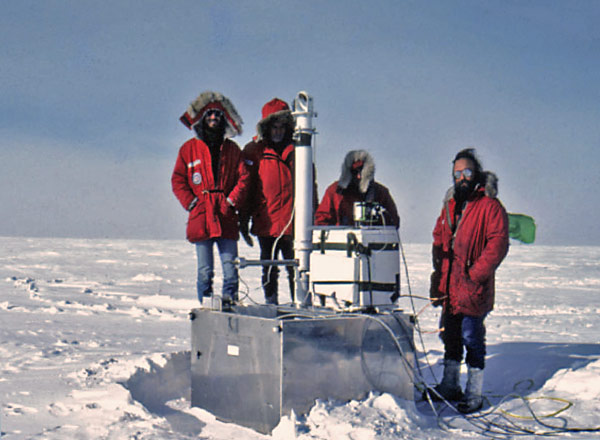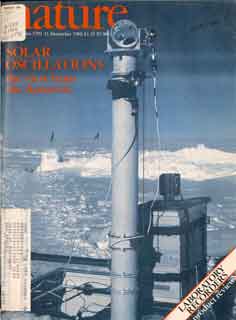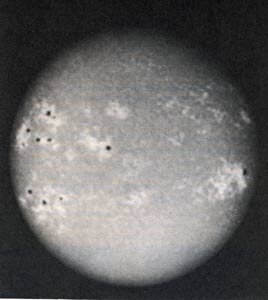The first funded astronomy project
 The telescope, out at what would become known as Pomerantz Land, during the 1979-80 summer. From left, Eric Fossat, Martin Pomerantz, Lyman Page (the 1979 McMurdo cosray winterover), and Gérard Grec (photo credit: Gérard Grec)
The instrument was set up in 1978-79 near an unoccupied hut between the dome and the skiway (one of the runway markers is visible in the photo) and eventually it was operated for 120 consecutive hours, with photos of the solar disk taken every 10 minutes. Other measurements were taken with a calibrated photometer, and the results impressed everyone, including the NSF representative at Pole, astronomer Larry Randall. As a result, Marty's project "Long-Term Continuous Observations of Large-Scale Motions and Structures on the Sun," was funded for the 1979-80 summer season. The project evolved...while the grant was focusing on the design of the "solar polar" tower telescope (which would appear at Pole in 1980-81), 1971 UCLA gravity winterover Bernie Jackson put Marty in touch with French researcher Eric Fossat from Nice Observatory. Eric had developed a sodium optical resonance spectrophotometer to study solar oscillations. After Marty and Eric met at Bartol, they decided to use Eric's instrument with Marty's telescope optics, although they didn't have an opportunity to test it before the equipment showed up at Pole. When they got to Pole, Marty was surprised that they'd been supplied with not one but TWO Sprytes to transport them to the proposed research site...a ski-mounted plywood box housing a 50kw generator, and the sled-mounted white building which had originally been Zoller's hut. This hut was buried in a snow trench, and the telescope was set up 100'/30m away. (Marty would continue to use this building for his Pomerantz Land projects--here's some interesting documentation). The weather in December while they were setting up was relatively cloudy, but on 31 December Members of the team used the instrument again during the 1981-82 summer to extend the previous observations; this time the collaboration included the Kitt Peak National Observatory and the NASA/GSFA Southwest Solar Laboratory (both in Tucson, AZ) as well as Bartol. An array detector was added to provide increased angular resolution. The goal was to characterize solar acoustic modes with periods of around five minutes. This season the weather wasn't as good, but the team was able to collect 6,681 images during four observation periods. The paper about the 1979-80 project, "Solar oscillations: full disk observations from the geographic South Pole" by Gérard Grec, Eric Fossat, and Martin Pomerantz, appeared in the 11 December 1980 issue of Nature. The telescope was pictured on the cover of that issue (right); the paper is behind a paywall, although if you click the "Rent or Buy" button on the above link you can see the first page. | |
 Here is a closeup view of the instrument from the 1981-82 summer season. |
|
References:The group photo at the top of this page appears in the 2004 paper "The History of Astrophysics in Antarctica" by Balthasar T. Indermuehle, Michael G. Burton, and Sarah T. Maddison, which is available from CSIRO Publishing and from arXiv.org. | |


